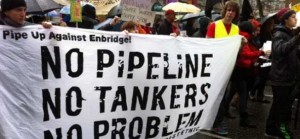The proposed Enbridge Northern Pipeline project is threatening the pristine Nak’azdli territory, home of the Yinka Dene Alliance, a coalition of six First Nations. The pipeline would risk destroying the precious waterways the Nak’azdli and the region’s other groups hold so dear to their hearts. A puncture, even as small as a “pinhole” leak, would alter decimate the salmon stock. The chances of that happening are once in 79 years (about 1.2 per cent a year)- A risk the First Nations aren’t willing to take. Roughly 40 per cent of First Nations in B.C. directly affected by the project have signed deals to take a financial stake in the pipeline, according to Enbridge’s calculations.
However, this does not include the five coastal First Nations that are so unwaveringly opposed, a key component why the pipeline construction has not been solidified. When such a large group of people is so vehemently opposed to the project, they can make a difference. The socio- cultural analysis of the area states that the coastal aboriginal peoples want no part of an oil pipeline. Risking their livelihoods and traditions passed on by generations for money is simply not an option for them. This is a prime example of external forces from the social-cultural facet affecting major economic factors of a business plan. In this case, Enbridge is forced to negotiate terms with the First Nations, and can’t simply steam role over them.
Works Cited
Hoekstra, Gordon. “There will be no pipeline.” http://www.vancouversun.com. Aug. 16, 2014 2014.Web. <http://www.vancouversun.com/news/There+will+pipeline/10122968/story.html>.
“Understanding Pest Analysis with Definitions and Examples.” http://pestleanalysis.com. Dec. 31, 2013 2013.Web. <http://pestleanalysis.com/pest-analysis/>.
